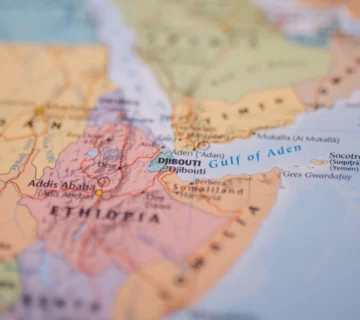The recent, escalating, and strategic al Shabab activities in Somalia and Kenya not only indicate the challenges of uprooting an ‘integrated’ enemy from within these two States, but also highlight the group’s desire to test the response of security officers. In addition to re-invigorating Kenya’s Boni Enclave Campaign (formally Operation Linda Boni), local, and cross-border multi-agency security teams must enhance intelligence-gathering, and alleviate ‘public panic,’ to ensure peace and security.
The December 28, 2019 car bomb attack in Somalia’s capital, Mogadishu, occurred at dawn. Omar Muhamoud, Mogadishu Mayor, said that at least 80 people were killed, and 125 injured near a manned security checkpoint, making this the deadliest attack in Mogadishu since the October 2017 one that left hundreds dead, and hundreds more injured. Most of those who were killed in the December incident were Somali university students, but fatalities included police officers and two Turkish citizens.
The location and timing of this incident are telling. Media coverage is comparatively more likely at day time than at night, and the attackers seemingly wanted to capitalize on the same to communicate their ability to successfully attack armed government troops in an AMISOM-secured (African Union Mission in Somalia) area. This attack was condemned by various leaders, and locals who protested and expressed their disgust with the group’s application of takfirism (act of declaring a Muslim a non-Muslim) in the Muslim-majority population.
Unlike in Kenya where al Shabab is a stubborn stain on the Kenyan social fabric, al Shabab’s forms part of Somalia’s socio-political fabric. The group’s interactions with locals has been lauded in some instances, because of the effect of ‘civility’ that their ‘governance’ has had in parts of the country. The group collects taxes, and provides services, such as sanitation, improved roads and security, for example. Thus, the members of the groups are not necessarily outright enemies. In other words, the group is generally integrated into the Somali community. This could also explain why the attack angered the community.
The Trio Factor
Three days later, al Shabab staged two other daring attacks in Kenya’s Lamu County. Considering that the manned locations were targeted in broad daylight, both of these attacks bore veins similar to the Mogadishu one. On January 2, 2020, the group ambushed a convoy of Lamu-bound buses plying the Mombasa-Lamu route on the Lamu-Garsen Road. Raymond Kahindi, a driver of one of the buses, reported no casualties on his bus but said several passengers from another bus in the convoy were harmed. Some locals also reportedly spotted an estimated 30 suspected attackers in and around the scene; some of them spoke Kiswahili (local language). One of them, dressed in bui bui (clothing worn by Muslim women in the region), was filming the unfolding attack. Scores of other wounded ones sought a resident’s help in the Tana Delta region shortly after that before retreating into Boni forest. This forest is proximate to the two countries, and acts as a buffer zone. The Coast Regional Coordination, John Elungata, said four suspected attackers were killed, and one arrested following the incident. A resident reportedly encountered scores of wounded al Shabab militants in the Tana Delta region who wanted his help to meet their medical needs. They later retreated to the forest.
It would seem that, by attacking and filming a secured convoy of buses, the group wanted to achieve two goals. First, it was likely testing the nature and speed of the response of the security agencies that are active in the region. Secondly, the group needs content to propagate its propaganda in the future, and staged this attack, in part, to acquire footage. The extent to which they may have achieved these goals remains unclear. That said, it is apparent that these attackers are fairly indistinguishable in the County because they look like (some wear bui bui, for example), sound like (speak local language), are familiar with the goings-on of the area (including the schedule of the secured convoy), and with the forest (they emerge from and retreat to forest and/or areas surrounding it). This means that they have command over some territory, and/or have established some sort of cell network in the target area. The reality that the attackers are not necessarily strangers to the area has generated fear in the community.
In claiming responsibility for another attack, three days after the ambush on the bus convoy, in the same County, on January 5, 2020, al Shabab said it had “launched an attack at the US base that is home to hundreds of military personnel and serves as one of the many launch pads against us.” The US-Africa Command Centre which acts as a base for US’s Special Operations Force in Somalia, is located in Manda. At least five US citizens were hurt in the attack, three of them fatally. The fatalities, coupled with the location of the attack raised the stakes, making this the most lethal of the three attacks. Reacting to the attack, which al Shabab framed as a revenge mission, the Centre’s Director of Operations, Maj. Gen. William Gayler, summed the act as al Shabab’s attempt at eliminating “Western influence and ideas,” and advancing its “jihadist agenda,” and “establishing a self-governed Islamic territory” in the region. He also expressed US’s resolve to curtail the group.
Territorial matters
The three attacks, in three locations, three days apart were followed by three attempted, non-aggressive breaches on three security installations in Kenya’s capital, Nairobi, and in Nanyuki, a garrison town in central Kenya, as well as attack at the Daadab (refugee settlement). On January 6, 2020, an unarmed individual was reportedly arrested for taking images of an air force base in Nairobi. A shoot-out involving terrorists was reported at Dadaab. A day earlier, three unarmed individuals were arrested for reportedly trying to access a British Army camp near the Kenya Defence Force’s Laikipia Airbase forcefully. Several local security battalions are also located in the area. Like the individuals involved in the Lamu attacks, for example, the individuals at the bases in Nairobi and Nanyuki, are fairly indistinguishable in the respective locations. These terrorist-related activities, which have activated ‘public panic,’ and raised the security alert in the country – particularly in Lamu, Nanyuki, and Nairobi – send two main signals. On the one hand, the activities could be the kicks of an uneasy, dying horse, signalling that counter-terrorism efforts (including those of AMISOM) are bearing some fruit. On the other hand, al Shabab could be communicating its adaptability to the ongoing efforts.
As such, to further secure the two States, a reward system should be established to incentivize citizens who identify and expose members of the group. Secondly, persons of interest should be processed, according to the law, and guilty ones charged. Thirdly, surveillance and the gathering of actionable intelligence in communities that are exposed to terrorist activity should be increased to bolster security efforts. Additionally, Boni forest is a good place to demonstrate US’s resolve to rob al Shabab of a safe haven in the region. The Boni Enclave Campaign (formally Operation Boni Forest) should be re-invigorated to drive the group out of the mangrove forest. Following that, the area manned around the clock, using canines, and human and artificial intelligence, to prevent the group’s re-entry. Security teams should also anticipate and prepare to counter new al Shabab propaganda offline and online.
The investments (including appropriate personnel and equipment) may not be fully guaranteed, as these depend on factors such as the counter-terrorism policies of more-endowed countries. The current US administration, for example, has reduced its spending on counter-terrorism efforts in parts of Africa. The US should consider reviewing this policy, and revise it in ways that will help to counter violent extremism in the two countries, and, by extension, the region. In the meantime, round-the-clock vigilance should be maintained to pre-empt and prevent more attacks and maintain peace in the region.
Roselyne Omondi is the Associate Director, Research, at the HORN Institute.
Photo: Smoke billows in a section in Manda Air Strip, Lamu County (Kenya) on January 5, 2020. An attempted breach by al Shabab was successfully repulsed by Africom soldiers (Photo Credit: Xinhua)



